| 1 | Marketing Concepts and Definitions |
The concept of selling recorded music has been around for more than a century. While the actual storage medium for music has evolved, from cylinders to vinyl discs, to magnetic tape, digital discs and now downloads, the basic notion has remained the same: a musical performance is captured to be played back at a later time, at the convenience of the consumer.
In today’s marketplace, the consumer is showered with an array of products from which to choose, making the process of marketing more important than ever. Before explaining how records (recorded music) are marketed to consumers, it is first necessary to gain a basic understanding of marketing.
Marketing is simply defined as the performance of business activities that direct the flow of goods and services from the producer to the consumer (Committee on Definitions, 1960). Marketing involves satisfying customer needs or desires. To study marketing, one must first understand the notions of product and consumer (or market). The first questions a marketer should answer are, “What markets are we trying to serve?” and, “What are their needs?” Marketers must understand these consumer needs and develop products to satisfy those needs. Then, they must price the products effectively, make the products available in the marketplace, and inform, motivate and remind the customer. In the music business, this involves supplying consumers with the recorded music they desire.
The market is defined as consumers who want or need your product and who have the willingness and ability to buy. This definition emphasizes that the consumer wants or needs something. A product is defined as something that will satisfy the customer’s want or need. You may want a candy bar, but not necessarily need one. You may need surgery, but not necessarily want it.
The marketing mix refers to a blend of product, distribution, promotion and pricing strategies designed to produce mutually satisfying exchanges with the target market. This is often referred to by the four P’s, which are:
1. Product – goods or services designed to satisfy a customer’s need
2. Price – what customers will exchange for the product
3. Promotion – informing and motivating the customer
4. Place – how to deliver and distribute the product
The marketing mix begins with the product. It would be difficult to create a strategy for the other components without a clear understanding of the product to be marketed. New products are developed by identifying a market that is underserved, meaning there is a demand for products that is not being adequately met.
The product aspect of marketing refers to all activities relating to the product development, ensuring that:
![]() There is a market for the product
There is a market for the product
![]() It has appeal
It has appeal
![]() It sufficiently differs from other products already in the marketplace
It sufficiently differs from other products already in the marketplace
![]() It can be produced at an affordable and competitive price
It can be produced at an affordable and competitive price
An array of products may be considered to supply a particular market. Then the field of potential products is narrowed to those most likely to perform well in the marketplace. In the music business, the Artist and Repertoire (A&R) department performs this task by searching for new talent and helping decide which songs will have the most consumer appeal. In other industries, this function is performed by the Research and Development (R&D) arm of the company.
New products introduced into the marketplace must somehow identify themselves as different from those that currently exist. Marketers go to great lengths to position their products to ensure that their customers understand why their product is more suitable for them than the competitor’s product. Product positioning is defined as the customer’s perception of a product in comparison with the competition.
Consumer tastes change over time. As a result, new products must constantly be introduced into the marketplace. New technologies render products obsolete and encourage growth in the marketplace. For example, the introduction of the compact disc (CD) in 1983 created opportunities for the record industry to sell older catalog product to customers who were converting their music collections from the LP (long playing record) to CD. Similarly, when a recording artist releases a new recording, marketing efforts are geared toward selling the new release, rather than older recordings (although the new release may create some consumer interest in earlier works and they may be featured alongside the newer release at retail).
The product life cycle
The product life cycle (PLC) is a concept used to describe the course that a product’s sales and profits take over what is referred to as the lifetime of the product—the sales window and market for a particular product, from its inception to its demise.
It is characterized by four distinct stages: introduction, growth, maturity and decline. Preceding this is the product development stage, before the product is introduced into the marketplace. The introduction stage is a period of slow growth as the product is introduced into the marketplace. Profits are nonexistent because of heavy marketing expenses. The growth stage is a period of rapid acceptance into the marketplace and profits increase. Maturity is a period of leveling in sales mainly because the market is saturated—most consumers have already purchased the product. Marketing is more expensive (to the point of diminishing returns) as efforts are made to reach resistant customers and to stave off competition. Decline is the period when sales fall off and profits are reduced. At this point, prices are cut to maintain market share (Kotler, P. and Armstrong, G., 1996).
The PLC can apply to products (a particular album), product forms (artists and music genres), and even product classes (cassettes, CDs and vinyl). Product classes have the longest life cycle—the compact disc has been around since the early 1980s. However, the life cycle of an average album release is 12–18 months.
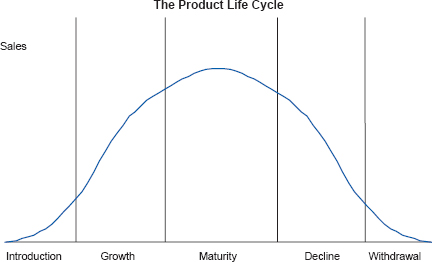
![]() Figure 1.1 The product life cycle
Figure 1.1 The product life cycle
Diffusion of innovations
When a product is introduced into the marketplace, its consumption is expected to follow a pattern of diffusion. Diffusion of innovations is defined as the process by which the use of an innovation is spread within a market group, over time and over various categories of adopters (Dictionary of Marketing Terms, American Marketing Association, 2004). The concept of diffusion of innovations describes how a product typically is adopted by the marketplace and what factors can influence the rate (how fast) or level (how widespread) of adoption. The rate of adoption is dependent on consumer traits, the product, and the company’s marketing efforts.
Consumers are considered adopters if they have purchased and used the product. Potential adopters go through distinct stages when deciding whether to adopt (purchase) or reject a new product. These stages are referred to as AIDA, which under one model is represented as attention, interest, desire and action. Another model uses awareness, information, decision and action. These stages describe the psychological progress a buyer must go through in order to get to the actual purchase. First, a consumer becomes aware that they need to make a purchase in this product category. Perhaps the music consumer has grown tired of his or her collection and directs his/her attention toward buying more music. The consumer then seeks out information on new releases and begins to gain an interest in something in particular, perhaps after hearing a song on the radio or attending a concert. The consumer then makes the decision (and desires) to purchase a particular recording. The call to action is the actual purchase.
This process may take only a few minutes or may take several weeks, depending on the importance of the decision and the risk involved in making the wrong decision. Involvement refers to the amount of time and effort a buyer invests in the search, evaluation and decision processes of consumer behavior. If the consumer is not discriminating and dissatisfaction with the decision is not a setback, then the process may take only moments and is thus a low-involvement situation. On the other hand, if the item is expensive, such as a new car, and if consequences of a wrong decision are severe, then the process may take much longer. Several factors influence the consumers’ level of involvement in the purchase process, including previous experience, ease of purchase, interest, and perceived risk of negative consequences. As price increases, so does the level of involvement.
Consumers who adopt a new product are divided into five categories:
1. Innovators
2. Early adopters
3. Early majority
4. Late majority
5. Laggards
Innovators are the first 2.5% of the market (Rodgers, 1995) and are eager to try new products. Innovators are above average in income and thus the cost of the product is not of much concern. Early adopters are the next 13.5% of the market and adopt once the innovators have demonstrated that the new product is viable. Early adopters are more socially involved and are considered opinion leaders. Their enthusiasm for the new product will do much to assist its diffusion to the majority. The early majority is the next 34% and will weigh the merits before deciding to adopt. They rely on the opinions of the early adopters. The late majority represents the next 34%, and these consumers adopt when most of their friends have. The laggards are the last 16% of the market and generally adopt only when they feel they have no choice. Laggards adopt a product when it has reached the maturity stage and is being “deep discounted” or is widely available at discount stores. When introducing a new product, marketers target the innovators and early adopters. They will help promote the product through word of mouth.
Products (or innovations) also possess characteristics that influence the rate and level of adoption. Those include:
“Relative Advantage: the degree to which an innovation is perceived as better than what it supersedes. Compatibility: the degree to which an innovation is perceived as consistent with existing values, past experiences, and needs. Complexity: the degree to which an innovation is perceived as difficult to understand and use. Trialability: the degree to which an innovation may be experimented with on a limited basis. Observability: the degree to which the results of an innovation are visible to the receiver and others.” (Rogers, E. M., 1995).
One way marketers can increase the potential for success is by allowing customers to “try before they buy.” Listening stations in retail stores and online music samples have increased the level of trialability of new music. Marketers can improve sales numbers by ensuring the product has a relative advantage, that it is compatible, that it is not complex, and that consumers can observe and try it before they purchase.
The Boston Consulting Group growth-share matrix
Most companies produce a glut of products, some of which perform better than others. The Boston Consulting Group has come up with a method of classifying a company’s products based on market growth and market share. The resulting growth-share matrix can quickly indicate the potential for future sales of each product. Market growth is indicated by the vertical axis, with high growth at the top. Relative market share (relative to the competition) is indicated by the horizontal axis, with high market share located on the left side. Then products are placed in quadrants based on their relative market share and growth potential in that market.
Table 1.1 The Growth-Share Matrix (Source: The Boston Consulting Group)
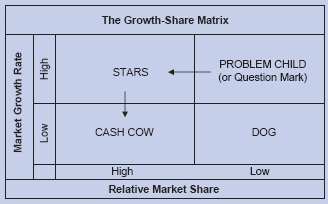
Stars: Stars are high-growth, high-share entities or products. Since the market for such products is still growing, they consume heavy investment to finance their rapid growth. In the recording industry, a genre of music showing growth (such as rap/hip-hop in the past decade) would be considered in the high market-growth category. An artist with a high relative market share (such as OutKast) would be considered a star.
Cash Cow: These business entities generate a high rate of return for little ongoing investment, and therefore, are very profitable for the company. These are established products with brand recognition and require less marketing dollars per unit sold. In the recording industry, established artists such as Elton John fall in to this category.
Problem Child: The problem child or question mark is a business unit that requires lots of cash and generates little return. They are low-share products in a high-growth market. The goal is to build these into stars by increasing market share while the market is still growing.
Dogs: These are low-growth, low-market share units with no promise of success. For record labels, this may represent artists who are no longer successful (or never had much success) in producing music in a genre that has stopped growing. The dogs should be relegated to niche markets at best.
The overall goal for a company after reviewing the portfolio of products is to attempt to move the problem children into the star category and to groom the star products to become tomorrow’s cash cows, while discontinuing the dogs.
Pricing is more complex than, “How much should we charge?” Pricing structure must be based on maximizing marketing success. Once the wholesale and retail pricing is determined, price-based incentives must then be considered. For example, should the product be put on sale? Should coupons be issued? Should the retailers receive wholesale price breaks for quantity orders or other considerations?
There are generally three methods for deciding the retail price of a product: cost-based pricing, competition-based pricing and consumer-based (value-based) pricing.
Cost-based pricing
Cost-based pricing is achieved by determining the cost of product development and manufacturing, marketing and distribution, and company overhead. Then an amount is added to cover the company’s profit goal. The weakness with this method is that it does not take into account competition and consumer demand.
![]()
When determining cost-based pricing, consideration must be given to the fixed-costs of running a business, the variable costs of manufacturing products, and the semi-variable costs related to marketing and product development. Fixed-costs include items such as overhead, salaries, utilities, mortgages, and other costs that are not related to the quantity of goods produced and sold. In most business situations, variable costs are usually associated with manufacturing and vary depending on the number of units produced. For recorded music, that would include discs, CD booklets, jewel cases, and other packaging. However, within the marketing budget of a record label, the costs of manufacturing and mechanical royalties are considered fixed once the number of units to be manufactured is determined and the recording costs have been computed. Then there are other (semi) variable costs, which can vary widely, but are not directly related to the quantity of product manufactured. They would include recording costs (R&D) and marketing costs. For purposes of the formula below, the costs of marketing are considered variable costs, and the recording and manufacturing costs, having already been determined for the project, are considered fixed at this point.
![]()
Table 1.2 Standard Business model vs. Record Label Business model
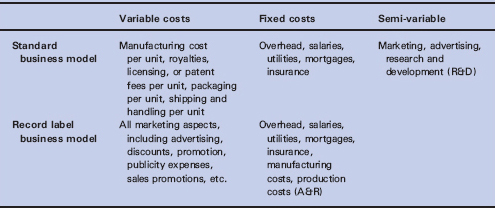
Competition-based pricing
Competition-based pricing attempts to set prices based on those charged by the company’s competitors—rather than demand or cost considerations. The company may charge more, the same, or less than its competitors, depending on its customers, product image, consumer loyalty and other factors.
Companies may use an attractive price on one product to lure consumers away from the competition to stimulate demand for their other products. This is known as leader pricing. The item is priced below the optimum price in hopes that sales of other products with higher margins will make up the difference. The most extreme case of this is loss leader pricing. Under loss leader pricing, the company actually loses money on one product in an attempt to bring in customers who will purchase other products that are more profitable. Compact discs are commonly used by retailers as loss leaders because it will generate traffic to the store and increase sales of other items.
Companies are prohibited from coordinating pricing policies to maximize profits and reduce competitive pricing. Such price fixing is illegal under the Sherman Act (1890), which prevents businesses from conspiring to set prices (Finch, J. E., 1996). The Robinson-Patman Act (1936) prohibits any form of price discrimination, making it illegal to sell products to competing buyers at different prices unless those price differentials can be justified.
Value-based (consumer-based) pricing
Compact discs are among those items priced based upon the consumer’s perceived value, rather than on any cost-based or competition-based factors. Consumer-based pricing uses the buyer’s perceptions of value, a reversal from the cost-plus approach. The music business has at times sought to maintain a high-perceived value for compact discs by implementing controversial pricing programs such as the minimum advertised price (MAP). In the 1990s, labels sought to discourage retailers from using CDs as loss leaders over concerns that, a) consumers would balk at paying full retail price for CDs that were not offered at the reduced price, and b) traditional retail stores would be driven out of business.
Promotion includes the activities of advertising, personal selling, sales promotion and public relations. It involves informing, motivating and reminding the consumer to purchase the product. In the recording industry, the four traditional methods of promotion include: radio promotion (getting airplay), advertising, sales promotion (working with retailers), and publicity. More recently, record labels have become more aggressive in marketing through street teams, Internet marketing, digital distribution, tour support, and tie-ins with other products.
Push vs. pull strategy
There are two basic promotion strategies: push promotion and pull promotion. A push strategy involves “pushing the product through the distribution channel to its final destination in the hands of consumers.” Marketing activities are directed at motivating channel members (wholesalers, distributors and retailers) to carry the product and promote it to the next level in the channel. In other words, wholesalers would be motivated to inspire retailers to order and sell more product. This can be achieved through offering monetary incentives, discounts, free goods, advertising allowances, contests, and display allowances.
All marketing activities are directed toward these channel members and are regarded as trade promotion and trade advertising. With a push strategy, channel members are motivated to “push” the product through the channel and ultimately on to the consumer.
Under the pull strategy, the company directs its marketing activities toward the final consumer, creating a demand for the product that will ultimately be fulfilled as requests for product are made from the consumer to the retailer, and then from the retailer to the wholesaler. This is achieved by targeting consumers through advertising in consumer publications and creating “consumer promotions.” With a pull strategy, consumer demand pulls the product through the channels.
Most large companies employ both strategies in a combination of consumer advertising and consumer promotions (coupons and sale items), and trade promotion (incentives).
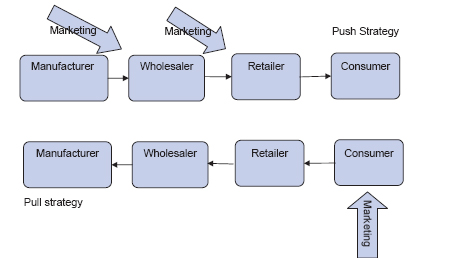
![]() Figure 1.2 Push vs. pull marketing strategy
Figure 1.2 Push vs. pull marketing strategy
This aspect of marketing involves the process of distributing and delivering the products to the consumer. Distribution strategies entail making products available to consumers when they want them, at their convenience. The various methods of delivery are referred to as channels of distribution. The process of distribution in the record business is currently in a state of evolution, as digital distribution becomes a reality. Questions remain as to how rapidly this new method of delivery will become adopted in the marketplace and what effect that will have on traditional distribution channels that deal with physical product.
Distribution systems
Most distribution systems are made up of channel intermediaries such as wholesalers and retailers. These channel members are responsible for processing large quantities of merchandise and dispersing smaller quantities to the next level in the channel (such as from manufacturer to wholesaler to retailer). Manufacturers engage the services of distributors or wholesalers because of their superior efficiency in making goods widely accessible to target markets (Kotler, P., 1980).
The effectiveness of intermediaries can be demonstrated in the following chart. In the first example, no intermediary exists and each manufacturer must engage with each retailer on an ongoing basis. Thus, the number of contacts equals the number of manufacturers multiplied by the number of customers or retailers (M, X, C). In the second example, a distributor is included with each manufacturer and each customer contacting only the distributor. The total number of contacts is the number of manufacturers plus the number of customers (M + C).

![]() Figure 1.3 Distribution models
Figure 1.3 Distribution models
The three basic types of distribution systems are corporate, contractual, and administered. All three are employed in the record business.
Corporate systems involve having one company own all distribution members at the next level in the channel. A record label would use a distribution system owned by the parent company, such as the relationship between Mercury Records and Universal Music and Video Distribution. Both companies are owned by Universal. This type of ownership is often referred to as vertical integration. When a manufacturer owns its distributors, it is called forward vertical integration. When a retailer such as Wal-Mart develops its own distribution or manufacturing firms, it is called backward vertical integration.
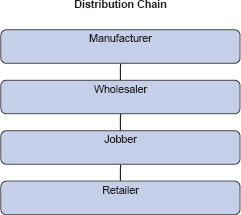
![]() Figure 1.4 Distribution chain
Figure 1.4 Distribution chain
Contractual distribution systems are formed by independent members who contract with each other, setting up an agreement for one company to distribute goods made by the other company. Independent record labels commonly set up such agreements with independent record distributors. Before the major record labels developed in-house distribution systems in the 1960s and 70s, nearly all recorded music was handled through this type of arrangement.
In administered distribution systems, arrangements are made for a dominant channel member to distribute products developed by an independent manufacturer. This type of arrangement is common for independent record labels that have agreements to be handled by the distribution branch of one of the major labels.
Retailing consists of all the activities related to the sale of the product to the final consumer for personal use. Retailers are the final link in the channel of distribution. There are numerous types of retailers, each serving a special niche in the retail environment. Independent stores focus on specialty products and customer service, while mass merchandisers such as Wal-Mart concentrate on low pricing. Online retailing of physical product through Amazon.com, CD Baby, and others has been growing in the past few years and the potential for selling music through downloads is creating both hope and fear among industry insiders.
In recent years, retailers have developed marketing tools to measure the effectiveness of product location in their stores. Universal product codes (UPC), or bar codes, and computerized scanners have helped retailers to determine the optimal arrangement of products within the store. They can move products around to various locations and note its effects on sales. As a result, retailers are charging manufacturers for prime space in the store, including counter space, end caps and special displays. Retail stores sometimes charge slotting fees—a flat fee charged to the manufacturer for placement of (mostly introductory) products on the shelves for a limited period of time. If the product fails to sell, the retail store has reduced its risk. A similar concept has developed in the record business, but it is also tied to promotion and favorable location for the product. It is referred to as price and position and will be discussed in the chapter on retailing.
The marketing strategy is the fundamental marketing plan by which the company intends to achieve its marketing objectives. It consists of a coordinated set of decisions based on target markets, the marketing mix, and the marketing budget. The marketing strategy is the “road map” or guide to growth and success.
The marketing plan for a company should start with an assessment of the company’s internal strengths and weaknesses, followed by an examination of the market environment. This situation analysis is sometimes referred to as a SWOT analysis (Strengths, Weaknesses, Opportunities and Threats). It is a review of the company’s present state, and an evaluation of the external and internal factors that can affect future success.
As a part of the SWOT analysis, the internal marketing audit is designed to examine the company’s areas of strength (the company’s competitive advantages) and weaknesses (the company’s vulnerable areas and underperforming units). Then, an assessment is conducted on the external opportunities (areas for growth) and threats (roadblocks and challenges) that exist for the company. The resulting investigation yields the SWOT analysis—strengths, weaknesses,opportunities and threats. A SWOT assessment allows the marketing department to determine:
![]() Where the company is right now
Where the company is right now
![]() Where the company needs to go
Where the company needs to go
![]() How to best get there
How to best get there
A SWOT analysis for a record label may yield some of the following findings.
|
Table 1.3 The SWOT analysis |
|
|
Strengths • Strong roster • Strong catalog • Skilled label personnel • Effective distribution • Abundant finances • Reputation |
Weaknesses • Underperforming artists on roster • Expenses are too high • Unhappy artists leaving label (or suing • Artist legal problems • Loss of label personnel |
|
|
|
Opportunities • New technologies • New markets (international or domestic) • Piracy controls • Trends swing your direction • International trade agreements |
Threats • Piracy • Censorship • Competition • Economic downturn • Loss of retail opportunities • New technology |
The SWOT helps the marketing department determine marketing strategy, including the identification of suitable markets and appropriate products to meet the demand. The company can then engage in sales forecasting, budgeting, and projection of future profits.
In the book Marketing: Relationships, Quality, Value, Nickels and Wood use Motown Records in their example of a SWOT analysis (Nickels, W. G. and Wood, M. B., 1997). Motown’s main strength is its strong catalog of 1960s and 70s music, including the Supremes, Four Tops, The Jackson Five, Michael Jackson and Boyz II Men. A weakness is their lack of start-up urban and rap artists compared to other labels such as Interscope. Opportunities exist in the nostalgia fads that periodically emerge, creating a demand for the old recordings. A threat they mention is “a shift in popular interest away from the label’s music.”
The SWOT analysis helps the company discover its core competencies, which enables the company to surpass the competition. However, it is the product marketing plan that helps to coordinate the strategic efforts to promote a particular product. It is a carefully planned strategy “with specialists in the areas of artist development, sales, distribution, advertising, promotion, and publicity joining forces in a coordinated effort to break an artist and generate sales” (Lathrop, T. and Pettigrew, J., 1999).
Channels of distribution – The various methods of distributing and delivering products ultimately to the consumer.
Competition-based pricing – Attempts to set prices based on those charged by the company’s competitors.
Consumer-based pricing – Using the buyer’s perceptions of value to determine the retail price, a reversal from the cost-plus approach.
Cost-based pricing – Determining retail price based on the cost of product development and manufacturing, marketing and distribution, and company overhead and then adding the desired profit.
Diffusion of innovations – The process by which the use of an innovation (or product) is spread within a market group, over time and over various categories of adopters.
EAN – The European Article Numbering system. Foreign interest in UPC led to the adoption of the EAN code format, similar to UPC but allows extra digits for a country identification, in December 1976.
Involvement – The amount of time and effort a buyer invests in the search, evaluation and decision processes of consumer behavior.
Loss leader pricing – The featuring of items priced below cost or at relatively low prices to attract customers to the retail store.
Marketing – The performance of business activities that direct the flow of goods and services from the producer to the consumer (American Marketing Association, 1960). Marketing involves satisfying customer needs or desires.
Marketing mix – A blend of product, distribution, promotion and pricing strategies designed to produce mutually satisfying exchanges with the target market. Often referred to as the four P’s.
Price fixing – The practice of two or more sellers agreeing on the price to charge for similar products.
Product class – A group of products that are homogeneous or generally considered as substitutes for each other.
Product form – Products of the same form make up a group within a product class.
Product life cycle – The course that a product’s sales and profits take over what is referred to as the lifetime of the product.
Product positioning – The customer’s perception of a product in comparison with the competition.
Pull strategy – The company directs its marketing activities toward the final consumer, creating a demand for the product that will ultimately be fulfilled as requests for product are made from the consumer.
Push strategy – Pushing the product through the distribution channel to its final destination through incentives aimed at retail and distribution.
Situation analysis – The systematic collection and study of past and present data to identify trends, forces, and conditions with the potential to influence the performance of the business and the choice of appropriate strategies.
SWOT analysis – An examination of both the internal factors (to identify strengths and weaknesses) and external factors (to identify opportunities and threats).
Universal Product Code (UPC) – An American and Canadian coordinated system of product identification by which a ten-digit number is assigned to products. The UPC is designed so that at the checkout counter an electronic scanner will read the symbol on the product and automatically transmit the information to a computer that controls the sales register.
Bibliography
American Marketing Association (1960). Marketing Definitions: A Glossary of Marketing Terms, Committee on Definitions, Chicago: American Marketing Association.
Committee on Definitions (1960). Marketing Definitions: A Glossary of Marketing Terms, Chicago: American Marketing Association.
Dictionary of marketing terms: American Marketing Association (2004). www.marketingpower.com.
Finch, J. E. (1996). The Essentials of Marketing Principles, Piscataway, NJ: REA.
Kotler, P. and Armstrong G. (1996). Marketing: An Introduction, Upper Saddle River, NJ: Prentice Hall.
Kotler, P. (1980). Principles of Marketing, Englewood Cliffs: Prentice-Hall.
Lathrop, T. and Pettigrew, J. (1999). This Business of Music Marketing and Promotion, New York: Billboard Books.
Nickels, W. G. and Wood, M. B. (1997). Marketing: Relationships, Quality, Value, New York: Worth Publishers.
Rogers, E. M. (1995). Diffusion of Innovations (4th edition), New York: The Free Press.
